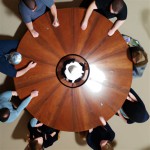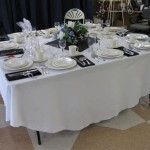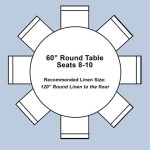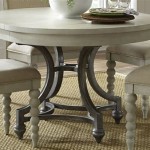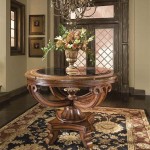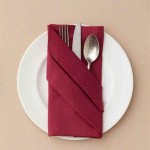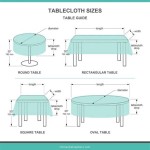Floor Plan Dining Table: Optimizing Space and Style
The selection of a dining table for any residential or commercial space is more complex than simply choosing an aesthetically pleasing piece of furniture. It requires careful consideration of spatial dimensions, intended function, and desired aesthetic. One critical element often overlooked is the integration of the dining table with the overall floor plan. A poorly chosen or ill-positioned dining table can disrupt traffic flow, diminish usable space, and negatively impact the overall ambiance of a room. Conversely, a well-considered dining table, selected and positioned with the floor plan in mind, can enhance both the functionality and the visual appeal of a dining area.
The floor plan, whether it be a formal blueprint or a simple mental visualization, serves as the foundational guide for determining the optimal size, shape, and placement of a dining table. It allows for a systematic assessment of the available space, potential traffic patterns, and relationship to adjacent rooms. This ensures that the chosen dining table not only meets the practical needs of the occupants but also complements the existing architectural design and interior decor.
This article explores the key considerations when choosing a dining table with the floor plan in mind, providing insights into spatial requirements, shape selection, material choices, and stylistic coherence. The aim is to equip designers, homeowners, and renters with the knowledge necessary to make informed decisions that maximize space utilization and achieve a harmonious integration of the dining table within the overall living environment.
Understanding Spatial Requirements and Traffic Flow
Before even considering the style or material of a dining table, it is imperative to assess the available space. This involves measuring the dimensions of the dining area, accounting for any architectural features such as doorways, windows, or built-in cabinetry. A crucial factor is leaving adequate space around the table for comfortable movement. A minimum of 36 inches, and ideally 42-48 inches, should be maintained between the edge of the table and any walls or other furniture. This clearance allows individuals to comfortably pull out chairs, sit down, and move around the table without obstruction.
Traffic flow is another critical aspect of spatial planning. The dining table should be positioned in a manner that does not impede the natural movement of people through the room or between adjacent areas. Consider the primary pathways that connect different spaces and ensure that the dining table does not create a bottleneck or force individuals to navigate around it awkwardly. In open-concept floor plans, the dining area often serves as a transitional space, and the placement of the table should facilitate a smooth and intuitive flow between the living room, kitchen, and other areas.
For smaller spaces, a careful evaluation of the spatial requirements is even more important. Opting for a smaller table or a space-saving design, such as a drop-leaf table or a table that can be easily folded and stored, may be necessary to maximize the usable area. In such cases, multi-functional furniture, like a dining table that can double as a workspace, can be an excellent solution. In larger, open-plan homes, a generously sized dining table can serve as a focal point, defining the dining area and creating a sense of separation from other living spaces.
Ultimately, understanding the spatial constraints and desired traffic flow patterns within the room is paramount to choosing a dining table that will not only fulfill its intended function but also enhance the overall usability and comfort of the space. Ignoring these considerations can lead to a cluttered, cramped, and uncomfortable environment.
Choosing the Right Shape for Your Floor Plan
The shape of a dining table significantly impacts the functionality and aesthetics of a dining area. The choice of shape should be guided by the dimensions of the room, the number of people typically seated at the table, and the desired style. Common dining table shapes include rectangular, square, round, and oval, each offering unique advantages and disadvantages depending on the specific context.
Rectangular dining tables are the most common choice, particularly for larger dining rooms or spaces where a more formal setting is desired. Their elongated shape lends itself well to seating a larger number of people and creating a sense of linearity and order. Rectangular tables are well-suited for rooms that are longer than they are wide, as they can help to visually elongate the space. However, in smaller rooms, a rectangular table can feel overwhelming and impede traffic flow. It is important to ensure that there is sufficient space around the table for comfortable movement and seating.
Square dining tables are best suited for smaller spaces or for seating a smaller number of people. Their symmetrical shape creates a sense of balance and intimacy, making them ideal for intimate dinners or casual gatherings. Square tables can also be effectively used in square-shaped rooms, where they can visually complement the existing geometry. However, square tables may not be suitable for larger groups as they tend to limit the number of people who can comfortably sit around the table.
Round dining tables are known for their versatility and ability to foster conversation. Their circular shape eliminates corners, creating a more inclusive and collaborative atmosphere. Round tables are well-suited for smaller spaces as they take up less visual space and allow for easier movement around the table. They are particularly effective in creating a cozy and intimate dining experience. However, round tables may not be ideal for formal dining settings or for seating a large number of people, as the circular shape can limit the space available for place settings and serving dishes.
Oval dining tables offer a compromise between the rectangular and round shapes. They provide the elongated seating capacity of a rectangular table while softening the sharp corners and promoting a more inclusive atmosphere. Oval tables are well-suited for rooms that are slightly longer than they are wide, as they can help to visually elongate the space without feeling as rigid as a rectangular table. They are a good option for those who want to combine the functionality of a rectangular table with the social benefits of a round table.
The shape of the dining table should also be considered in relation to the shape of the room and the placement of other furniture. Consider the overall symmetry and balance of the space and choose a table shape that complements the existing architectural features and furniture arrangement. When possible, consider unconventional shapes such as an organically shaped table for a modern feel. These shapes can add visual interest and uniqueness to a dining space.
Material Choices and Style Coherence
The material and style of a dining table should complement the overall design aesthetic of the room and the existing furniture. The choice of material can significantly affect the durability, maintenance requirements, and visual appeal of the table, while the style should align with the overall theme of the space.
Wood dining tables are a classic and versatile choice, suitable for a wide range of design styles. Different types of wood, such as oak, maple, walnut, and pine, offer varying degrees of durability, grain patterns, and color tones. Oak and maple are known for their strength and durability, making them ideal for high-traffic areas. Walnut offers a rich, warm color and a distinctive grain pattern, while pine is a more affordable option that can be easily painted or stained to match any decor. The finish of the wood can also affect the overall look and feel of the table, from a natural, matte finish to a high-gloss lacquer.
Glass-top dining tables offer a sleek and modern aesthetic, creating a sense of openness and lightness in the room. Glass tables are particularly well-suited for smaller spaces as they visually recede into the background, making the room feel larger. However, glass tables can be more prone to scratches and require regular cleaning to maintain their pristine appearance. The base of a glass table can be made from a variety of materials, such as metal, wood, or acrylic, allowing for a customized look that complements the existing decor.
Metal dining tables offer a durable and industrial-chic look, often featuring a clean, minimalist design. Metal tables are particularly well-suited for modern or contemporary spaces, adding a touch of edginess and sophistication. They can be made from a variety of metals, such as steel, iron, or aluminum, each offering unique properties and finishes. Metal tables are also relatively easy to maintain, requiring only occasional cleaning with a damp cloth.
Beyond the primary table material, the overall style should be consistent with the rest of the room. If the dining area is part of a modern, minimalist home, a sleek glass or metal table with clean lines would be a natural fit. For a more traditional or rustic setting, a solid wood table with a distressed finish would be more appropriate. Mixing and matching styles can be done, but should be carefully considered to avoid clashing elements. For example, pairing a modern table with traditional chairs could work if there is a unifying element, such as a shared color palette or material.
The style of the dining table should also be considered in relation to the surrounding furniture. The chairs, lighting fixtures, and decorative accessories should all work together to create a cohesive and harmonious look. Consider the scale and proportion of the table and chairs, ensuring that they are appropriately sized for the room and for the intended use. For example, in a formal dining room, larger, more ornate chairs may be appropriate, while in a casual dining area, smaller, more comfortable chairs may be preferred.
In choosing a dining table, the material and style are key factors to harmonize the space's design and ensure the dining area complements the existing furniture and maintains a consistent aesthetic.

Dining Room Floor Plan Templates

Free Vectors Floor Plan Dining Set

Large Dining Room Layouts And Floor Plan Ideas
Dining Table Floor Plans

Dining Table Floor Plan Vector Images Over 170

Metric Data 08 Standard Furniture Sizes

Dining Room Design

Dining Room Furniture Layout With 8 X 10 Rug

Furniture For The Floor Plan Top View Tables Office And Dinner Room Perfect Interior Mood Boards Planning Sketches Architectural 32188416 Vector Art At Vecy

Simple Dining Room Floor Plan Template
Related Posts

